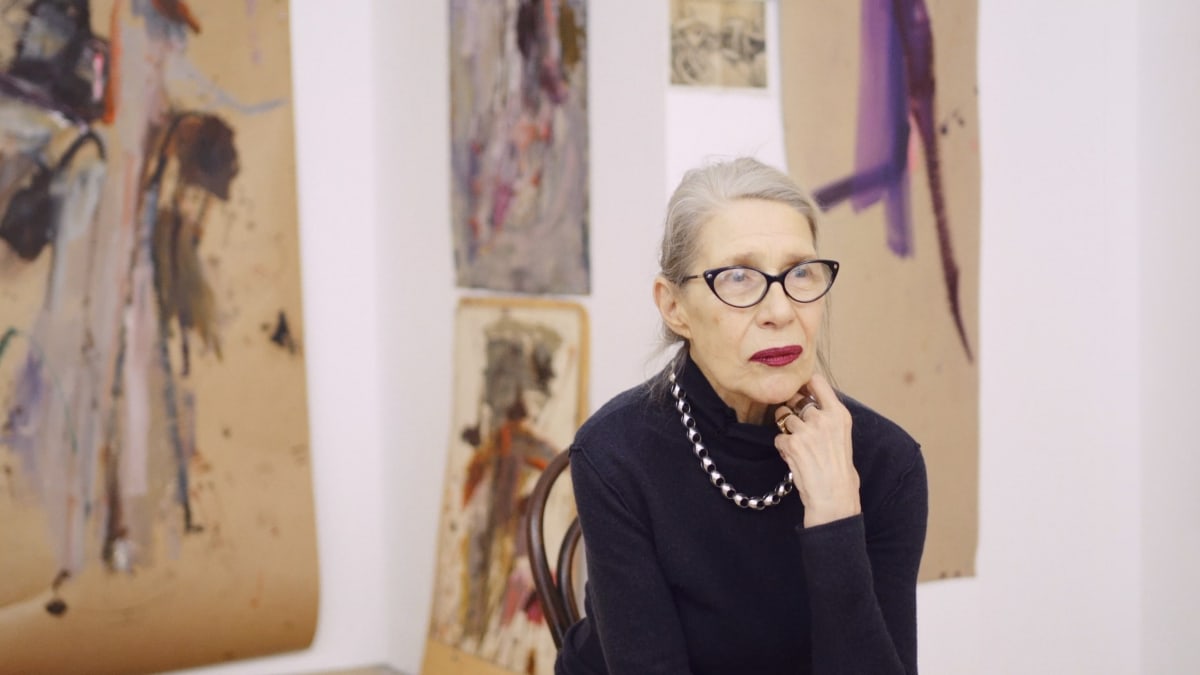Martha Jungwirth The Austrian painter looking to Goya and the horrors of Australian bushfires
By Julia Michalska
Pinned to the wall of Martha Jungwirth’s studio in Vienna, between images of dinosaurs and newspaper clippings, is a photograph of two footballers battling over a ball. Who the players are is irrelevant, the point is the drama and dynamism of their movement. In the Austrian artist’s work, action in the external world often collides with her internal life to form vast colour fields on paper, marked with what she calls flecken (blotches). Jungwirth’s works were marginalised for decades, but now, the 84-year-old artist is represented by the blue-chip dealer Thaddaeus Ropac and has major exhibitions at the Guggenheim Museum in Bilbao and the Palazzo Cini Gallery in Venice. Jungwirth spoke to us about the subjects that spark her ferocious painting process and the gradual upwards trajectory of her artistic career.
The Art Newspaper: Can you tell us about your exhibition in Bilbao? How has it been organised?
Martha Jungwirth: It is a retrospective, but there are also works from the past two years included—so practically up to now. The narrative follows the themes that have occupied me right from the beginning: objects and portraits, landscapes, animals and art history.
In the first section, there are three large drawings from the Indesit series, which were also exhibited at Documenta 6 [in 1977]. The starting point for this series was my first trip to New York, where I became completely fascinated by the city. At the Museum of Modern Art, there was an exhibition of architectural drawings by Mies van der Rohe that impressed me greatly. I am always driven by strong emotions and visual experiences that trigger something in me. When I returned, I sat at home in my kitchen and made these large drawings of a dishwasher. When you open such a household appliance, it has these same structures, which can all be associated with architecture; you just need the necessary imagination.
Then the exhibition continues with portraits. I only actually portrayed my husband. He didn’t distract me while I was painting, he didn’t say anything, it was based on trust. When strangers sit for me, their presence always unsettles me.
Then come the landscapes: Greece appears frequently, because I was there very often, [as does] Rome, where I was with my husband, New York, etcetera. Animals started to interest me more in my work after they were so horribly wiped out by all these forest fires. We give such little consideration to people, and even less so to animals. It affects me; it really hurts. I painted animals from my imagination. In Australia, three billion animals burned [in 2019-20], which is unimaginable, terrible.
The section about art history concentrates on the past two years, in which I have been exploring Goya and Manet. Years ago, I was in Madrid with my husband and we went to the Prado and saw Goya. We also went outside the city to the church where he painted the frescoes. Goya feels so contemporary in our time: all the etchings, Los desastres de la guerra (1810-20), are very current. Nothing has changed, it is as it always was.
Then there was a large Goya exhibition at the Fondation Beyeler in Basel [in 2021]. I wanted to go, but it was during the corona time, and I was afraid. Now I regret not going, but I ordered the catalogue and locked myself in and studied Goya. The cover of the catalogue was the painting of the Maja, the nude and the clothed [La maja desnuda (1795-1800) and La maja vestida (1800-07)], and that’s where I started. When something captures my interest, it sometimes develops very quickly.
You have another show on at the Palazzo Cini Gallery in Venice, inspired by Joseph Conrad’s Heart of Darkness. What sparked that interest?
I buy the Frankfurter Allgemeine Zeitung (FAZ) every day, and there was a big article about the French journalist Albert Londres, who in 1909 or 1910 looked at what was really happening in the colonies; not what the ministers in France were telling people, he really investigated all the madness. He was attacked and had various lawsuits against him. Londres wrote about all the places where colonialism was rampant at the time. He didn’t live very long; he died in a shipwreck. In 2020 his book Africa in Chains was translated into German, which was the reason for the article in the FAZ. It mentioned that the major Paris Colonial Exhibition of 1931 took place at the Palais de la Porte Dorée in Paris, for which it was constructed.
The topic began to interest me more and more. The starting point was the article in the FAZ; then I bought the book and spent three days in Paris visiting this museum. It’s about migration and immigration, from the first migrations, over the 17th century, where the first Africans were kidnapped, and then the colonial period, where everything was exploited. The worst was the Belgian king.
I also went to the Musée du quai Branly—Jacques Chirac. It shows everything that was looted. I found the museum itself hideous, with these fake mud buildings and red floor. It was really unpleasant. These visits intensified everything. I then came home and painted the pictures all at once. The memory and emotions were very intense and very complex, and that’s why I painted the series. I painted them in 14 days; when the emotion is strong and I feel it’s going well, it happens quickly.














































































































































































